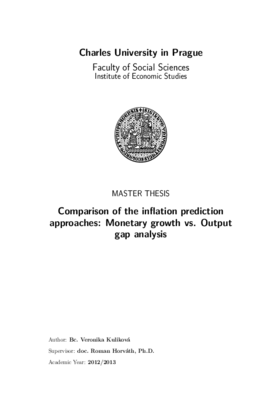Comparison of the inflation prediction approaches: Monetary growth vs. Output gap analysis
Porovnání přístupu k inflačním predikcím: Růst peněz vs. mezera výstupu
diplomová práce (OBHÁJENO)

Zobrazit/
Trvalý odkaz
http://hdl.handle.net/20.500.11956/60013Identifikátory
SIS: 125667
Katalog UK: 990016231290106986
Kolekce
- Kvalifikační práce [19618]
Autor
Vedoucí práce
Oponent práce
Babin, Adrian
Fakulta / součást
Fakulta sociálních věd
Obor
Ekonomie
Katedra / ústav / klinika
Institut ekonomických studií
Datum obhajoby
11. 9. 2013
Nakladatel
Univerzita Karlova, Fakulta sociálních vědJazyk
Angličtina
Známka
Výborně
Klíčová slova (česky)
inflácia, Bayesovské priemerovanie modelov, medzera výstupu, ponuka peňazí, modelová neistotaKlíčová slova (anglicky)
inflation, Bayesian Model Averaging, output gap, money supply, model uncertaintyInflácia je doležitý peňažný indikátor často používaný pri vykonávaní monetárnej politiky. Aj keď je ponuka peňazí významný determinant inflácie, nie je používaná v jej modelovaní. V súčasnosti je za veličinu s najväčšou výpovednou hodnotou pri určovaní inflácie považovaná medzera vo výstupe. Táto diplomová práca empiricky dokazuje pravdivosť hypotézy že peňažná ponuka obsahuje viac informácií o pohybe inflácie ako medzera vo výstupe. Tento fakt je ukázaný na prípade 16 vyspelých európskych ekonomík za použitia Bayesovského Modelového Priemerovania (BMA). BMA je ucelená metóda, ktorá sa zaoberá neistotou modelovania a rieši problém výberu veličín do modelu. Výsledky analýzy potvrdili že peňažná ponuka obsahuje viac informácií o inflácii ako medzera vo výstupe a preto by mala byť používaná v modelovaní inflácie. Tieto výsledky sú robustné voči nastaveniu parametrov modelu a vysokej korelácii niektorých premenných.
Inflation is one of the often used monetary indicators in conducting monetary policy. Even though money supply is an essential determinant of inflation, it is not used in inflation modeling. Currently, output gap is considered as most predicative variable. This thesis brings the empirical evidence on the hypothesis of money supply carrying more information on estimating inflation than the output gap. It is provided on the case of 16 developed European economies using Bayesian Model Averaging (BMA). BMA is a comprehensive approach that deals with the model uncertainty and thus solves the variable selection problem. The results of analysis confirmed that money supply includes more information of inflation than the output gap and thus should be used in inflation modeling. These outcomes are robust towards prior selection and high correlation of some variables.
